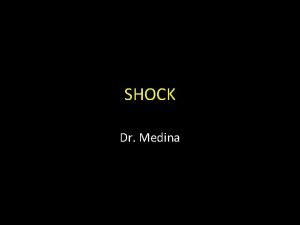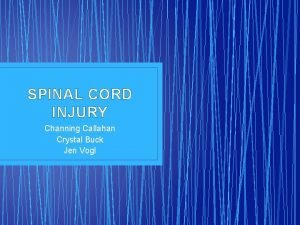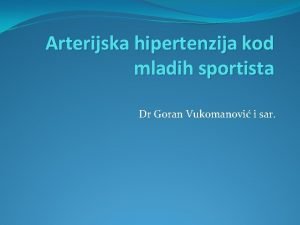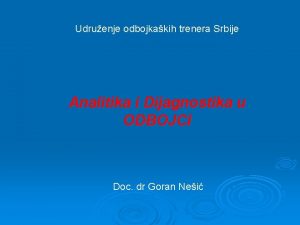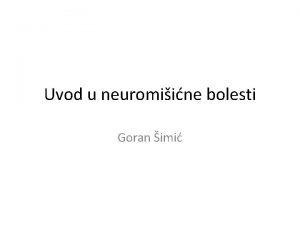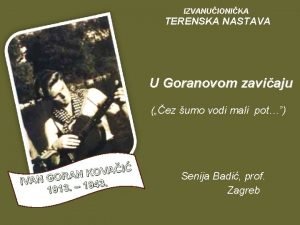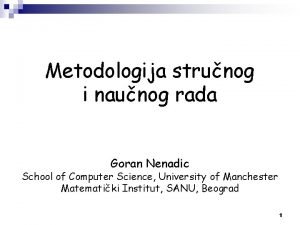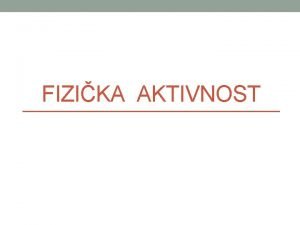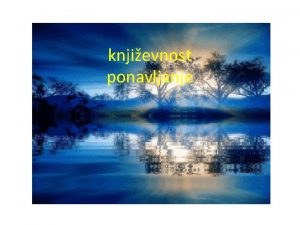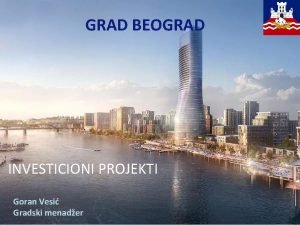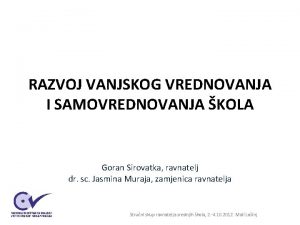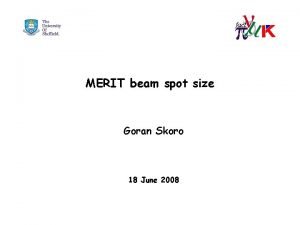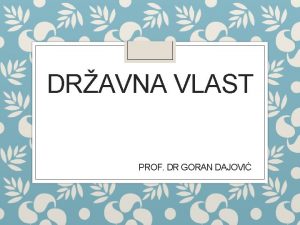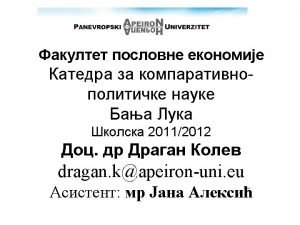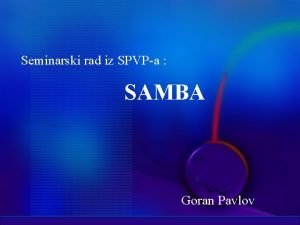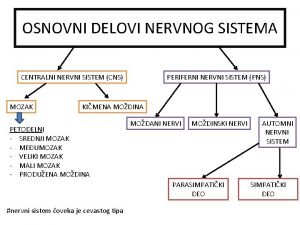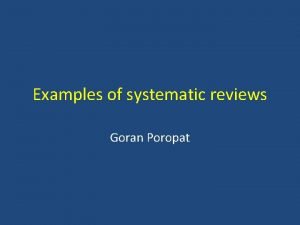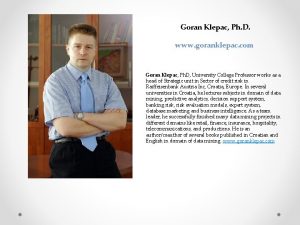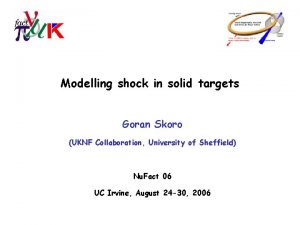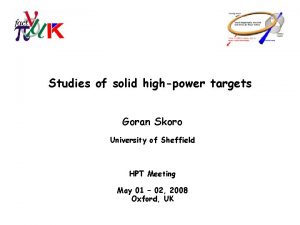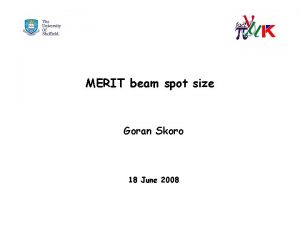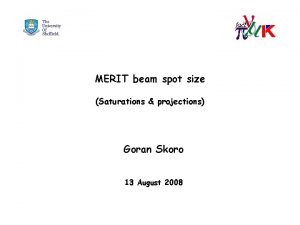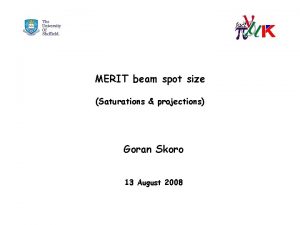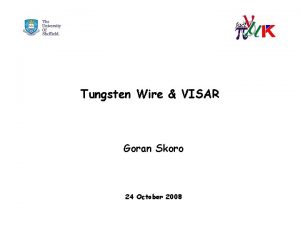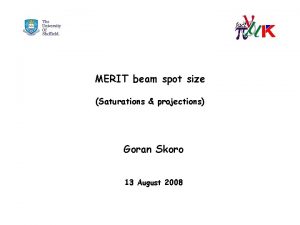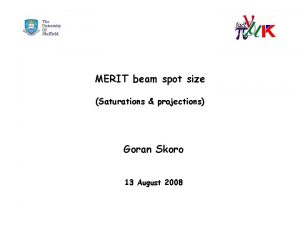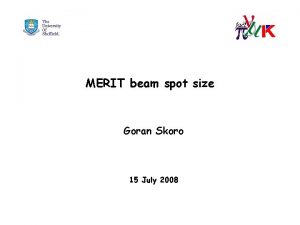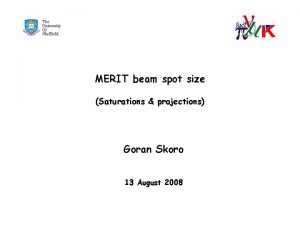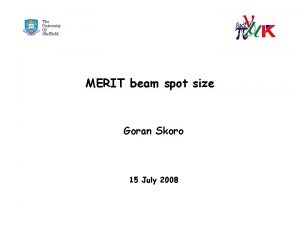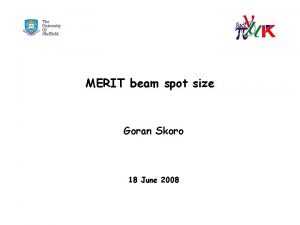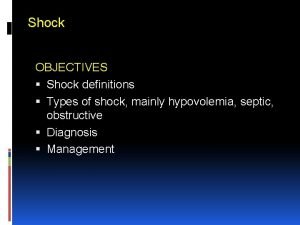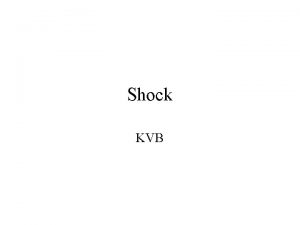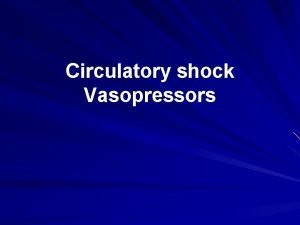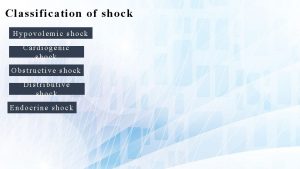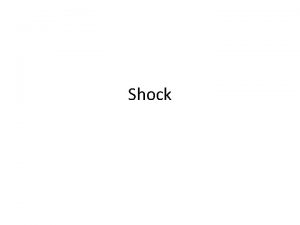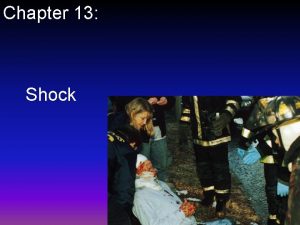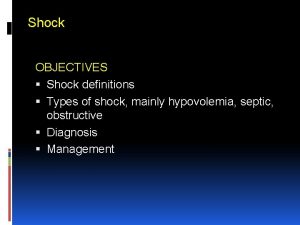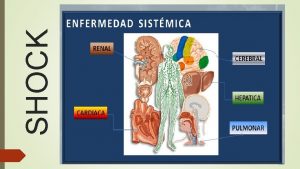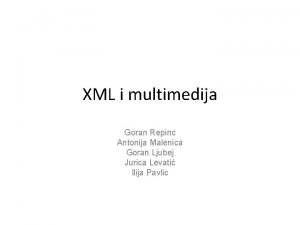Modelling shock in solid targets Goran Skoro UKNF




![Stress in graphite target Peak Stress [MPa] Von Mises LS-DYNA Stress in 2 cm Stress in graphite target Peak Stress [MPa] Von Mises LS-DYNA Stress in 2 cm](https://slidetodoc.com/presentation_image_h2/54cce0d4192f6435550049d1a2b23966/image-5.jpg)

















![surface displacement [ m] Comparison with the tests at the ISOLDE EXPERIMENT Tantalum Cylinder, surface displacement [ m] Comparison with the tests at the ISOLDE EXPERIMENT Tantalum Cylinder,](https://slidetodoc.com/presentation_image_h2/54cce0d4192f6435550049d1a2b23966/image-23.jpg)

- Slides: 24

Modelling shock in solid targets Goran Skoro (UKNF Collaboration, University of Sheffield) Nu. Fact 06 UC Irvine, August 24 -30, 2006

Estimation of thermal stress in materials Thermal Stress ~ E T/(1 - ) T=EDD/Cp - thermal expansion coefficient E – elastic modulus T- temperature rise - Poisson’s ratio EDD – energy deposition density Cp – specific heat strain =f(T); E=f(T); Cp=f(T) !!! Thermal stress as a function of temperature for different materials?

High temperature target candidates: Ta, W, Nb(? ), Mo(? )… 20 J/g corresponds to ~ 300 J/cc in Ta (and W) - energy density for 4 -5 MW beam power, 6 -10 Ge. V protons -

Assuming that the tensile strength (=f(T)) is a measure of material mechanical strength we can introduce ‘stress quality’ factor = thermal stress/tensile strength lower value of stress quality factor -> ‘better’ candidate for solid target (T 2 K) W looks better than Ta Graphite is ‘special’ NB. Inconclusive strength data for Molybdenum. Looks interesting in general (it is valuable alloying agent). Almost all ultra-high strength steels contain Mo in amounts from 0. 25 to 8%.
![Stress in graphite target Peak Stress MPa Von Mises LSDYNA Stress in 2 cm Stress in graphite target Peak Stress [MPa] Von Mises LS-DYNA Stress in 2 cm](https://slidetodoc.com/presentation_image_h2/54cce0d4192f6435550049d1a2b23966/image-5.jpg)
Stress in graphite target Peak Stress [MPa] Von Mises LS-DYNA Stress in 2 cm diameter, 66 cm long graphite target beam power: 4 MW, 50 Hz; energy deposition from MARS; 4 x 2 ns bunches per pulse; 10 s macro-pulse length. longitudinal radial Stress is not the main problem for graphite target! supported Beam energy [Ge. V]

Simulations of the shock in the solid Neutrino Factory target • Rotating toroidal ring (operating at ~2000 K); • Individual bars. . . • Cooling: radiation • The target is bombarded at up 50 Hz by a proton beam consisting of ~1 ns long bunches in a pulse of a few micro-s length. High temperature candidates: TANTALUM, TUNGSTEN, . . . 20 cm 2 cm • The target material exposed to the beam will be ~ 20 cm long and ~2 cm in diameter (in tantalum case). micro-pulse macro-pulse Beam: protons, 3 – 30 Ge. V • Energy density per pulse ~ 300 J/cc. ISS baseline (April 2006): 4 MW, 10 Ge. V, 50 Hz, 4 bunches per pulse, 2 ns rms.

Simulations. . . as realistic as possible High energy particle cascade calculations (MARS) Energy deposition in solid target Temperature rise in solid target Input for thermal stress calculations (LS-DYNA) Here: TANTALUM, Beam power = 5 MW, repetition rate = 50 Hz

LS-DYNA simulations • • Temperature Dependent Bilinear Isotropic Model Uses 2 slopes (elastic, plastic) for representing of the stress -strain curve Inputs: density, Young's modulus, CTE, Poisson's ratio, yield stress, . . . stress [MPa] • Material model used in the analysis strain LS-DYNA input (estimate; especially for T> 1000 K) • “Theory” • Problems with material data: reliable data can be found for temperatures up to 1000 K (but inconclusive); no data (practically) at high temperatures.

LS-DYNA simulations (TANTALUM) micro-pulse macro-pulse characteristic time (shock transit time) = characteristic length / speed of sound in material factor of 2 difference in shock magnitude optimal macro-pulse length (topt) (let's say) from 10 to 30 s radial characteristic time longitudinal characteristic time topt

“Proof”: T 2 K target results MARS • Graphite Bar Target : r=15 mm, L=900 mm (2 interaction length) – Energy deposit … Total: 58 k. J/spill, Max: 186 J/g T 200 K Distribution of the energy deposit in the target (w/ 1 spill) J/g beam cm macro-pulse length = 5 s length = 90 cm characteristic time (radial) = 10 s length = 1. 5 cm length = 0. 3 cm Slicing of the target does not help if shock transit time is bigger than macro-pulse length

LS-DYNA simulations (TANTALUM) for fixed beam power (5 MW) and repetition rate (50 Hz) for 2 different macro-pulse lengths (3 s) and (10 s) micro-pulse macro-pulse Peak stress as a function of beam energy (normalized on mean energy density)

LS-DYNA simulations (TANTALUM) Stress per deposited power - at the level of 250 MPa per MW - 'mean peak value' = averaged peak (von Mises) stress across the target measure of 'concentration' of deposited energy

Status of simulations of the current pulse – wire tests at RAL Experiment (Tantalum wire) The wire is 0. 5 mm diameter, tantalum. Originally it protruded from the graphite top connection by 0. 5 mm and ended up protruding 3 mm. The wire ran for 16 hours at 3. 125 Hz repetition rate. The wire was run at 100 C rise per pulse for the first 6. 5 hours, . . . The last 5 hours was at 4900 A, pulse, corresponding to a temperature rise or 150 C per pulse. The peak temperature. . . was estimated to be ~1300 C. One can see that the wire has become reduced in radius in parts and is thicker in others.

LS-DYNA simulations • • Geometry Rise time: ~100 ns 0. 5 mm diameter; 40 mm long wire; supported at bottom, free at top Flat Top: ~500 ns Loads Current pulse: ~ 5 k. A, exponential rise 30 ns risetime fitted to the waveform Time, 100 ns intervals • • Lorentz force induced pressure wave strain Energy density; temperature rise across the wire

LS-DYNA simulations • • • Multiple pulses Pulse time (heating) ~ 600 ns; temperature rise per pulse ~ 110 C Time between pulses (cooling) ~ 300 ms; LS-DYNA needs 115 h to complete 1 pulse! 50 pulses (16 h to complete); • • APPROXIMATION: Time T=300 K between pulses (cooling)~ 500 s; 50 x longer than (longitudinal) characteristic time! temperature rise ~ 1300 C strain final cooling ↔ 500 x longer time than (longitudinal) characteristic time.

Results Tantalum wire: 0. 5 mm diameter, 40 mm long EXPERIMENT: Originally it protruded from the graphite top connection by 0. 5 mm and ended up protruding 3 mm. free Simulation: 0. 5 mm 50 pulses elements at the centreline plastic deformation supported LS-DYNA

Results Tantalum wire: 0. 5 mm diameter, 40 mm long EXPERIMENT: One can see that the wire has become reduced in radius in parts and is thicker in others. reduced free thicker in radius 50 pulses reduced elements at the surface reduced supported LS-DYNA plastic deformation SIMULATION

Tungsten wire test • Geometry 0. 5 mm diameter; 30 mm long wire Loads • Current pulse: ~7 k. A, 800 ns long Initial temperature = 2300 K Peak current can be ‘tuned’ to have a wanted value of the peak stress in the wire

Comparison: Stress in real target vs. stress in tungsten wire Peak Von Mises Stress [MPa] Test result (7. 5 k. A, 800 ns long pulse) Tungsten wire (after a few minutes at 7. 2 k. A) Stress in tungsten wire (7. 5 k. A, 800 ns long pulse) Stress in 2 x 17 cm tungsten target (4 MW, 50 Hz, 6 Ge. V) supported Macro pulse length [ s] LS-DYNA

Comparison: Stress in real target vs. stress in tungsten wire Stress in 3 x 20 cm tungsten target (4 MW) Stress in tungsten wire (5 k. A, 800 ns long pulse) “Stress in 2 x 17 cm tungsten target” (2 MW) This wire had survived over 3 million pulses at 5 k. A. Bent into this severe shape within a few minutes at 7. 2 k. A. S. supported Brooks Solution: bigger target radius? It looks possible. Captured yield practically the same for 1 cm radius -> 1. 5 cm radius.

“Additional” stress in the target: for example when beam is not at a target axis (target bending, etc…) LS-DYNA (3 D) Peak Von Mises Stress [MPa] 2 x 17 cm Tungsten target Beam radius = Rod radius = 1 cm 33 MPa; ~10% rise 3 x 20 cm Tungsten target Beam radius = Rod radius = 1. 5 cm 46 MPa; ~33% rise TUNGSTEN target operating at 2000 K Power = 4 MW, repetition rate = 50 Hz, Beam energy = 6 Ge. V (parabolic distribution) 4 x 2 ns long bunches in a 10 s long pulse Energy deposition from MARS (S. Brooks) Beam offset [in rod radius units]

(1) beam Beam radius = rod radius; Beam offset = 1/2 radius. (1) (2) Peak Stress = 170 MPa (3) beam (2) beam Peak Stress = 175 MPa (3) Peak Stress = 182 MPa Tungsten target: 3 x 20 cm Beam: 4 MW, 50 Hz, 6 Ge. V, 4 x 2 ns, 10 s Energy deposition from MARS (S. Brooks) LS-DYNA (3 D)
![surface displacement m Comparison with the tests at the ISOLDE EXPERIMENT Tantalum Cylinder surface displacement [ m] Comparison with the tests at the ISOLDE EXPERIMENT Tantalum Cylinder,](https://slidetodoc.com/presentation_image_h2/54cce0d4192f6435550049d1a2b23966/image-23.jpg)
surface displacement [ m] Comparison with the tests at the ISOLDE EXPERIMENT Tantalum Cylinder, 1 x 10 cm 17 44 13 34 1. 4 9 24 0. 9 5 14 1 4 2. 4 1. 9 0. 4 LS-DYNA simulations Goran SKORO, Sheffield University 40 30 20 10 0

Summary • Solid target for the Neutrino Factory: • • Shock waves in candidate materials (Ta, W, C) characterised within limitations of material knowledge Effects of beam pulse length and multiple bunches/pulse understood (stress reduction by choosing optimal macro-pulse length) Test of wire: • • First estimate of the lifetime of tantalum (and tungsten) NF target • Repeat experiment with graphite and the others candidate materials VISAR is purchased to measure surface velocity of wire and compare results with LS-DYNA calculations (this will help to extract high temperature material data from experiment) Conclusions • • • Nice agreement between LS-DYNA and existing experimental results 2 MW -> looks possible in 2 cm diameter target (W is better than Ta) 4 MW -> needs bigger target diameter (2 cm -> 3 cm)
 T10 spinal cord
T10 spinal cord Site:slidetodoc.com
Site:slidetodoc.com Spinal shock vs neurogenic shock
Spinal shock vs neurogenic shock Normovolemico
Normovolemico Spinal shock vs neurogenic shock
Spinal shock vs neurogenic shock Solid
Solid Dr goran vukomanovic
Dr goran vukomanovic Neuropsihologija
Neuropsihologija Motorička jedinica
Motorička jedinica Mali pot ivan goran kovačić analiza pjesme
Mali pot ivan goran kovačić analiza pjesme Goran nenadic
Goran nenadic Goran dimitric
Goran dimitric Gustav krklec zagorski vinograd
Gustav krklec zagorski vinograd Beograd
Beograd Distorsio art
Distorsio art Göran lindahl abb
Göran lindahl abb Goran sirovatka
Goran sirovatka Goran shadows
Goran shadows Dravna
Dravna Goran milas
Goran milas Goran gabrilo
Goran gabrilo Goran pavlov
Goran pavlov Centar refleksne radnje
Centar refleksne radnje Goran repinc
Goran repinc Goran vesi
Goran vesi



